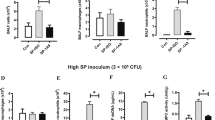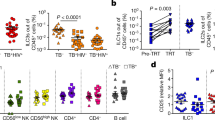Abstract
We have characterized leukocyte migration to the pleural cavity in a methylated-BSA (mBSA)-induced model of murine delayed-type hypersensitivity and evaluated the ability of IL-4 and IL-10 to modulate this response. Neutrophils, macrophages, T cells, and dendritic cells migrated to the pleural cavity in a time-dependent fashion following direct intrapleural antigen challenge, with neutrophils comprising the majority of exudate leukocytes in the cavity within the first 24 h and the number of mononuclear cells increasing at later times. Real-time quantitative PCR analysis of infiltrating leukocytes revealed a marked elevation of steady-state mRNA levels of IL-1β and TNFα and the chemokines KC, MIP-2, CXCL9, CXCL10, CXCL11, CCL2, CCL3, and CCL4 at 6 h postchallenge, which diminished over time. In contrast, γIFN mRNA levels were maximal at 24 h and CCL5 expression was sustained throughout 72 h. ELISA analysis of pleural exudate fluid revealed significant elevations of KC and CCL2 protein levels at 6 h postantigen challenge and a peak increase in γIFN protein at 24 h, confirming our mRNA observations. Administration of recombinant murine IL-4 or IL-10 prior to challenge significantly blocked cell trafficking to the pleural cavity as well as peak levels of exudate γIFN, with IL-4 being more potent in impairing these responses. IL-4 administration also increased the proportion of naïve T cells in the pleural cavity, as judged by CD62L and CD45RB expression. These results indicate that this in vivo model demonstrates a pattern of events associated with Th1-mediated leukocyte trafficking and underscore the potential utility of this in vivo model for evaluating therapeutic inhibitors of leukocyte trafficking.
Similar content being viewed by others
References
Gerard, C. and B. J. Rollins. 2001. Chemokines and disease. Nat. Immunol. 2:108–115.
Mckay, C. R. 2001. Chemokines: Immunology's high impact factors. Nat. Immunol. 2:95–101.
Feldmann, M. 2001. Pathogenesis of arthritis: Recent research progress. Nat. Immunol. 2:771–773.
Davidson, A. and B. J. Diamond. 2001. Autoimmune diseases. N. Engl. J. Med. 345:340–350.
Brandtzaeg, P., G. Haraldsen, and J. Rugtveit. 1997. Immunopathology of human inflammatory bowel disease. Springer Semin. Immunopathol. 18:555–589.
Locati, M. and P. M. Murphy. 1999. Chemokines and chemokine receptors: Biology and clinical relevance in inflammation and AIDS. Annu. Rev. Med. 50:425–440.
Crowle, A. J., C. C. Hu, and A. Patrucco. 1968. Preferential development by mice of delayed hypersensitivity to purified basic proteins. J. Allergy 42:140–156.
Teixeira, M. M., A. Talvani, W. L. Tafuri, N. W. Lukacs, and P. G. Hellewell. 2001. Eosinophil recruitment into sites of delayed-type hypersensitivity reactions in mice. J. Leukoc. Biol. 69:353–360.
Lewis, A. J., J. Parker, J. DiLuigi, L. J. Datko, and R. P. Carlson. 1982. Immunomodulation of delayed hypersensitivity to methylated bovine serum albumin (mBSA) in mice using subliminal and normal sensitization procedures. J. Immunopharmacol. 3:289–307.
Yoshino, S. and J. Yoshino. 1998. Effect of a monoclonal antibody against interleukin-4 on suppression of antigen-induced arthritis in mice by oral administration of the inducing antigen. Cell Immunol. 187:139–144.
Brackertz, D., G. F. Mitchell, and I. R. Mackay. 1977. Antigen-induced arthritis in mice. I. Induction of arthritis in various strains of mice. Arthritis Rheum. 20:841–850.
Van Lent, P. L., A. J. van Vuuren, A. B. Blom, A. E. Holthuysen, L. B. van de Putte, J. G. van de Winkel, and W. B. van den Berg. 2000. Role of Fc receptor gamma chain in inflammation and cartilage damage during experimental antigen-induced arthritis. Arthritis Rheum. 43:740–752.
Van Lent, P. L., K. Nabbe, A. B. Blom, A. E. Holthuysen, A. Sloetjes, L. B. van de Putte, S. Verbeek, and W. B. van den Berg. 2001. Role of activatory FcγRI and FcγRII and inhibitory FcγRIII in inflammation and cartilage destruction during experimental antigen-induced arthritis. Am. J. Pathol. 159:2309–2320.
De Hooge, A. S. K., F. A. J. van de Loo, O. J. Arntz, and W. B. van den Berg. 2001. Involvement of IL-6, apart from its role in immunity, in mediating a chronic response during experimental arthritis. Am. J. Pathol. 157:2081–2091.
van de Loo, F. A., L. A. Joosten, P. L. van Lent, O. J. Arntz, and W. B. van den Berg. 1995. Role of interleukin-1, tumor necrosis factor alpha, and interleukin-6 in cartilage proteoglycan metabolism and destruction. Effect of in situ blocking in murine antigen-and zymosan-induced arthritis. Arthritis Rheum. 38:164–172.
Dunn, C. J. and S. K. Miller. 1986. The effects of cyclosprorin A on leucocyte infiltration and procoagulant activity in the mouse delayed hypersensitivity response in vivo. Int. J. Immunopharmacol. 8:635–643.
Fine, J. S., J. V. Jackson, A. Rojas-Triana, and L. A. Bober. 2000. Evaluation of chemokine-and phlogisitin-mediated leukocyte chemotaxis using an in vivo sponge model. Inflammation 24:331–346.
Chomarat, P. and J. Banchereau. 1998. Interleukin-4 and interleukin-13: Their similarities and discrepancies. Int. Rev. Immunol. 17:1–52.
Mosmann, T. R. 1994. Properties and functions of interleukin-10. Adv. Immunol. 56:1–26.
Jung, T. M., W. M. Gallatin, I. L. Weissman, and M. O. Dailey. 1988. Down-regulation of homing receptors after T cell activation. J. Immunol. 141:4110–4117.
Bradley, L. M., G. G. Atkins, and S. L. Swain. 1992. Long-term CD4+ memory T cells from the spleen lack MEL-14, the lymph node homing receptor. J. Immunol. 148:324–331.
Birkeland, M. L., T. Kraus, L. Tardelli, and E. Pure. 1992. Progressive changes in CD45RB phenotype and lymphokine production by murine CD4+ T cells after alloantigen exposure. Immunology 75:632–638.
Schall, T. J., J. Jongstra, B. J. Dyer, J. Jorgensen, C. Clayberger, M. M. Davis, and A. M. Krensky. 1988. A human T cell-specific molecule is a new member of a new gene family. J. Immunol. 141:1018–1025.
Lee, Y. C. and K. B. Lane. 2001. The many faces of transforming growth factor-beta in pleural diseases. Curr. Opin. Plum. Med. 7:173–179.
Peretti, M., C. Szabo, and C. Thiemermann. 1995. Effect of interleukin-4 and interleukin-10 on leucocyte migration and nitric oxide production in the mouse. Br. J. Pharmacol. 116:2251–2257.
Bober, L. A., A. Rojas-Triana, J. V. Jackson, M. W. Leach, D. Manfra, S. K. Narula, and M. J. Grace. 2000. Regulatory effects of interleukin-4 and interleukin-10 on human neutrophil function ex vivo and on neutrophil influx in a rat model of arthritis. Arthritis Rheum. 43:2660–2667.
Powrie, F., S. Menon, and R. L. Coffman. 1993. Interleukin-4 and interleukin-10 synergize to inhibit cell-mediated immunity in vivo. Eur. J. Immunol. 23:2223–2229.
Yano, S., H. Yanagawa, Y. Nishioka, N. Mukaida, K. Matsushima, and S. Sone. 1996. T helper 2 cytokines differently regulate monocyte chemoattractant protein-1 production by human peripheral blood monocytes and alveolar macrophages. J. Immunol. 157:2660–2665.
van Wely, C. A., P. C. L. Beverley, S. J. Brett, C. Britten, and J. P. Tite. 1999. Expression of L-selectin on Th1 cells is regulated by IL-12. J. Immunol. 163:1214–1221.
Carlow, D. A., S. Y. Corbel, M. J. Williams, and H. J. Ziltener. 2001. IL-2,-4 and-15 differentially regulate O-glycan brancing and P-selectin ligand formation in activated CD8 T cells. J. Immunol. 167:6841–6848.
Chao, C. C., R. Jensen, and M. O. Dailey. 1997. Mechanisms of L-selectin regulation by activated T cells. J. Immunol. 159:1686–1694.
D'Amico, G., G. Frascaroli, G. Bianchi, P. Tansidico, A. Doni, A. Vecchi, S. Sozzani, P. Allavena, and A. Mantovani. 2000. Uncoupling of inflammatory chemokine receptors by IL-10: Generation of functional decoys. Nat. Immunol. 1:387–391.
Biedermann, T., M. Kneilling, R. Mailhammer, K. Maier, C. A. Sander, G. Kollias, S. L. Kunkel, L. Hultner, and M. Rocken. 2000. Mast cells control neutrophil recruitment during T-cell mediated delayed-type hypersensitivity reactions through tumor necrosis factor and macrophage inflammatory protein 2. J. Exp. Med. 192:1441–1452.
Piguet, P. F., G. E. Grau, C. Hauser, and P. Vassalli. 1991. Tumor necrosis factor is a critical mediator in hapten-induced irritant and contact hypersensitivity reactions. J. Exp. Med. 173:673–679.
Chu, A., K. Hong, E. L. Berg, and R. O. Ehrhardt. 1999. Tissue specificity of E-and P-selectin ligands in Th1-mediated chronic inflammation. J. Immunol. 163:5086–5093.
Andres, P. G., P. L. Beck, E. Mizoguchi, A. Mizoguchi, A. K. Bhan, T. Dawson, W. A. Kuziel, N. Maeda, R. P. MacDermott, D. K. Podolsky, and H.-C. Reinecker. 2000. Mice with a selectin deletion of the CC chemokine receptors 5 or 2 are protected from dextran sodium sulfate-mediated colitis: Lack of CC chemokine receptor 5 expression results in a NK1.1+ lymphocyte-associated Th2-type immune response in the intestine. J. Immunol. 164:6303–6312.
De Jong, P., A. C. Abadia-Molina, A. R. Satoskar, K. Clarke, S. T. Rietdijk, W. A. Faubion, E. Mizoguchi, C. N. Metz, M. Al Sahli, T. ten Hove, A. C. Keates, J. B. Lubetsky, R. J. Farrell, P. Michetti, S. J. van Deventer, E. Lolis, J. R. David, A. K. Bhan, and C. Terhorst 2001. Development of chronic colitis is dependent on the cytokine MIF. Nat. Immunol. 2:1061–1066.
Author information
Authors and Affiliations
Corresponding author
Rights and permissions
About this article
Cite this article
Fine, J.S., Rojas-Triana, A., Jackson, J.V. et al. Impairment of Leukocyte Trafficking in a Murine Pleuritis Model by IL-4 and IL-10. Inflammation 27, 161–174 (2003). https://doi.org/10.1023/A:1025076111950
Issue Date:
DOI: https://doi.org/10.1023/A:1025076111950




